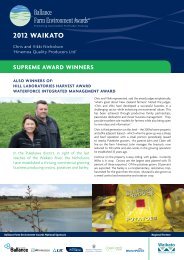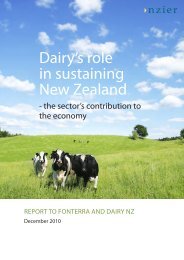NZIER report on compensation for transmission infrastructure
NZIER report on compensation for transmission infrastructure
NZIER report on compensation for transmission infrastructure
Create successful ePaper yourself
Turn your PDF publications into a flip-book with our unique Google optimized e-Paper software.
example, may encourage Transpower to run lines a shorter route over dairy land<br />
rather than over hill or high country where transmissi<strong>on</strong> towers impose significantly<br />
lower operati<strong>on</strong>al costs <strong>on</strong> farmers.<br />
Understating easement prices and the associated inefficiency issues<br />
may be addressed by providing a margin over estimated costs or<br />
periodic payments<br />
If settlements under-estimate the land value change imposed by easements,<br />
providing in compensati<strong>on</strong> a margin above the estimated change could eliminate<br />
under-pricing and generally create more efficient outcomes .The appropriate amount<br />
of additi<strong>on</strong>al compensati<strong>on</strong> would be impossible to determine, however, without<br />
detailed case studies to establish the extent of understatement in practice.<br />
A sec<strong>on</strong>d opti<strong>on</strong> would be to provide a means <strong>for</strong> agreements to be re-visited and<br />
compensati<strong>on</strong> amounts to be periodically adjusted. Although this would not provide<br />
more accurate easement price assessments a priori, it would require Transpower to<br />
allow <strong>for</strong> any potential change in future easement price be<strong>for</strong>e c<strong>on</strong>structi<strong>on</strong>. This may<br />
reduce the extent of easement under-pricing.<br />
A number of utilities provide compensati<strong>on</strong> greater than estimated<br />
easement costs and periodic adjustable payments<br />
Dissatisfacti<strong>on</strong> with compensati<strong>on</strong> <strong>for</strong> easements is widely <str<strong>on</strong>g>report</str<strong>on</strong>g>ed in countries<br />
similar to New Zealand. The issue of inefficiency is dealt with in Canada, Finland and<br />
the United Kingdom as utilities are required to provide compensati<strong>on</strong> greater than the<br />
estimated costs imposed <strong>on</strong> landowners from easements. Landowners have the<br />
opti<strong>on</strong> of receiving payments periodically with adjustments, rather than a lump-sum<br />
<strong>on</strong>ly.<br />
Other findings<br />
Practices in other countries<br />
There is a degree of similarity in how easement values are calculated in all of the<br />
countries we reviewed. Although details and amounts appear to be largely<br />
determined by relative negotiating strengths, compensati<strong>on</strong> is generally based <strong>on</strong>:<br />
Easement area and land value<br />
Operati<strong>on</strong>al costs<br />
Injurious affecti<strong>on</strong> (i.e. permanent change in land value after an easement is<br />
created)<br />
Disturbance.<br />
We found several examples of compensati<strong>on</strong> greater than estimated values and<br />
landowners being given the opti<strong>on</strong> of receiving compensati<strong>on</strong> annually rather than in<br />
a lump-sum.<br />
<str<strong>on</strong>g>NZIER</str<strong>on</strong>g> – Compensati<strong>on</strong> <strong>for</strong> transmissi<strong>on</strong> <strong>infrastructure</strong> iii
















